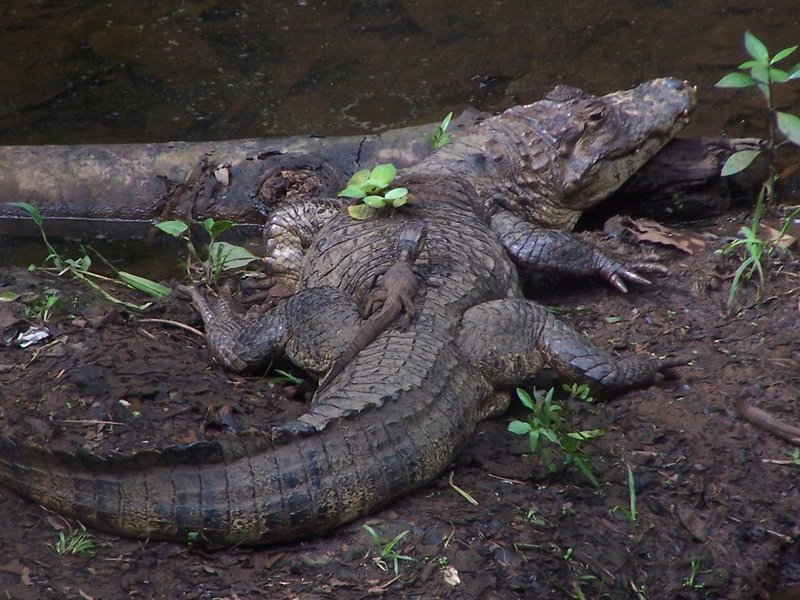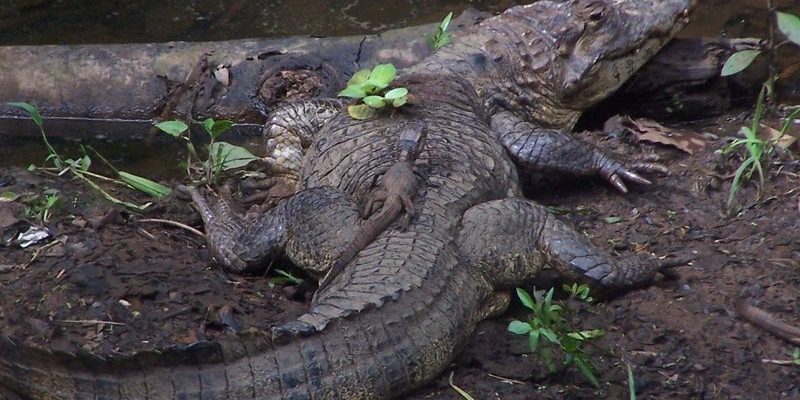
These magnificent reptiles can be found in various parts of Africa, lounging in the sun or gliding through rivers and lakes. But they’re not just any large reptiles; they have unique features that help set them apart from other crocodile species. If you’re keen on spotting one in the wild, understanding their distinct characteristics is crucial. So, let’s dive into the world of Nile crocodiles and learn how to recognize them when you spot them basking or swimming.
Distinctive Physical Features
To really know a Nile crocodile when you see one, you’ll want to familiarize yourself with its distinct physical features. First off, size matters. Nile crocodiles typically grow to around 11 to 16 feet in length, although some individuals can reach lengths of over 20 feet! Just thinking about standing next to one of these giants is enough to give anyone pause.
Next up is their skin. Nile crocodiles have a rugged, scaly exterior often a dark olive green or brown color. This natural camouflage helps them blend into their surroundings. Their scales are tough and armored, perfect for a life spent in water where they need to protect themselves from other predators—and even each other! What might catch your eye first are their powerful jaws. Equipped with around 60 sharp teeth, they can crush bones with ease. When they snap their jaws shut, it’s like a metallic clang!
Another notable feature is their eyes. The eyes of a Nile crocodile are positioned on top of their heads, allowing them to see while mostly submerged. If you spot two small eyes peeking out of the water, you might just be looking at one of these stealthy reptiles.
Behavior and Habitat
Understanding how Nile crocodiles behave can also help you identify them in the wild. They are cold-blooded reptiles, which means they rely on external temperatures to regulate their body heat. This leads them to bask in the sun for hours, especially on rocky ledges or sandy banks. If you see a group of large reptiles soaking up the sun, chances are they’re Nile crocodiles enjoying a lazy afternoon.
When it comes to water, Nile crocodiles prefer rivers, lakes, and swamps. They thrive in both freshwater and brackish water environments. Their habitat usually has plenty of vegetation along the banks, which provides excellent cover for hunting prey. If you’re near such a water source in Africa, keep your eyes peeled; crocodiles love to lie in wait for unsuspecting animals venturing close to the edge.
Another interesting aspect of their behavior is their social dynamics. Nile crocodiles can often be seen basking together, forming groups called “basks.” However, during mating season or when food is scarce, you may witness territorial disputes, as these reptiles can be quite aggressive towards one another.
Coloration and Patterns
Coloration is another key element in identifying Nile crocodiles. Their skin is typically a blend of dark greens, browns, and even some yellow hints, which can vary depending on their environment. For instance, crocodiles living in murky waters may appear darker compared to those in cleaner waters.
You might be wondering about the pattern on their skin, which consists of spots and a mottled appearance that help them camouflage against the riverbank or among the reeds. This coloring serves a dual purpose: it not only hides them from prey but also protects them from being spotted by predators.
When observing a Nile crocodile, take note of any unique markings or characteristics. Just like people have identifiers, so do these reptiles! Some individuals might have scars from fights or irregularities in coloration that make them easier to recognize on subsequent visits.
Habits of Hunting
Nile crocodiles are expert hunters, so their hunting habits can also provide clues to their identification. They usually hunt at dawn or dusk when their prey is most active. The large reptiles are known for their stealth, often lurking in the shallows, keeping perfectly still until the moment is right.
What’s fascinating is their ambush technique. They can remain submerged with just their eyes and nostrils above water, making it almost impossible to spot them. If you see ripple patterns around the edges of the water, keep watch!
Nile crocodiles are opportunistic eaters, which means they’ll consume a wide variety of food. Fish, birds, and even larger mammals like impalas can become a meal. You may see a crocodile suddenly spring into action, launching itself from the water to capture its prey. It’s a fierce reminder of why it’s essential to maintain that respectful distance while observing these incredible creatures.
Listening for Sounds
Believe it or not, crocodiles are vocal animals! If you find yourself near a Nile crocodile, you might hear low growls or hissing sounds. These vocalizations can indicate discomfort or aggression. Listening closely can provide additional clues for identification, especially if you spot one lying in the sun nearby.
During mating season, loud rumbling noises may fill the air as males call out to attract females. It’s one of nature’s fascinating symphonies, and recognizing these vocalizations can deepen your understanding of their behavior.
This auditory aspect adds another layer to the experience of spotting Nile crocodiles. Combining visual identification with sounds can help you paint a more complete picture of their activity in the wild.
Where to Find Nile Crocodiles
If you’re eager to spot a Nile crocodile, knowing where to look is half the battle. As mentioned earlier, they inhabit freshwater bodies throughout Africa. You’ll find them in countries like Egypt, Sudan, and Kenya, often lurking in rivers, lakes, and swamps.
Look for them along iconic rivers like the Nile River, which, fittingly, is home to their name. National parks such as Kruger National Park in South Africa and Lake Nakuru National Park in Kenya are also great places to observe these reptiles.
Timing is important too. Early morning or late afternoon is ideal for spotting them as they bask or hunt. If you’re on a boat tour or safari, keep your camera ready; you might capture a perfect moment of nature unfolding!
Staying Safe While Observing
While spotting a Nile crocodile can be an exhilarating experience, safety should always be a priority. These reptiles are powerful and can be unpredictable. Here are some safe practices:
- Maintain Distance: Always keep a safe distance—preferably at least 20 feet—between you and a crocodile.
- Avoid Feeding: Do not attempt to feed them; this can lead to dangerous situations.
- Stay in Groups: If you’re observing with others, stay together and keep an eye on your surroundings.
- Listen to Guides: If you’re on a tour, listen to your guide’s advice about staying safe.
By following these precautions, you can enjoy the thrill of spotting Nile crocodiles while prioritizing your safety and well-being.
Identifying a Nile crocodile in the wild can be an awe-inspiring experience. With their distinctive physical features, unique behaviors, and fascinating habitats, these reptiles hold a special place in the wildlife of Africa. Whether you’re on a safari or simply admiring nature from the riverbank, knowing what to look for can make all the difference.
Remember to stay safe, respect their space, and soak in the incredible experience of being in the presence of such magnificent creatures. By understanding how to identify Nile crocodiles, you can enhance your wildlife adventures and create lasting memories of the natural world’s wonders. Happy spotting!

